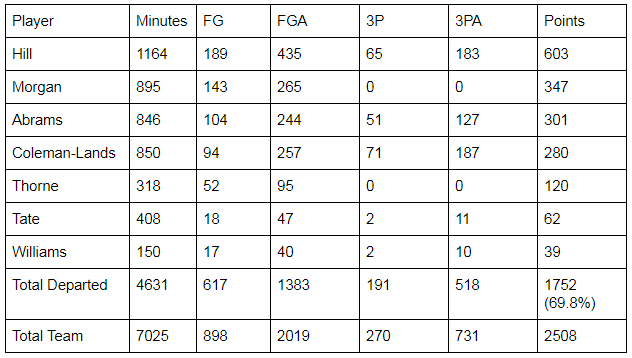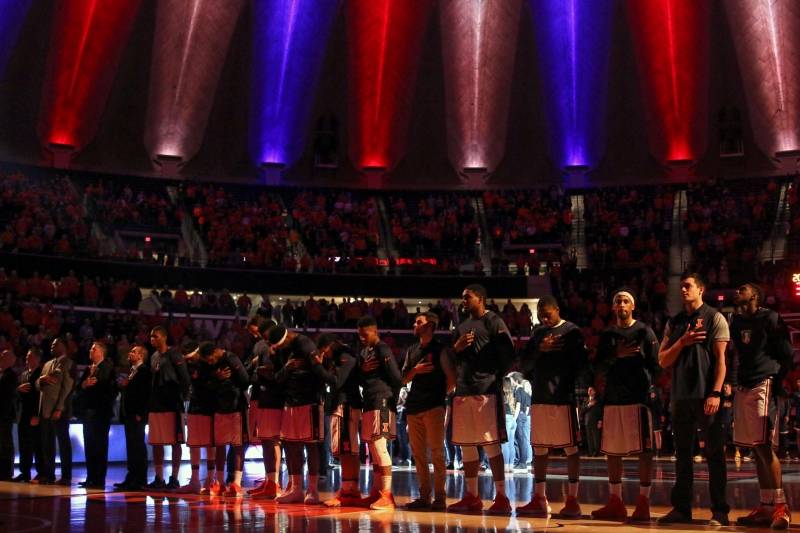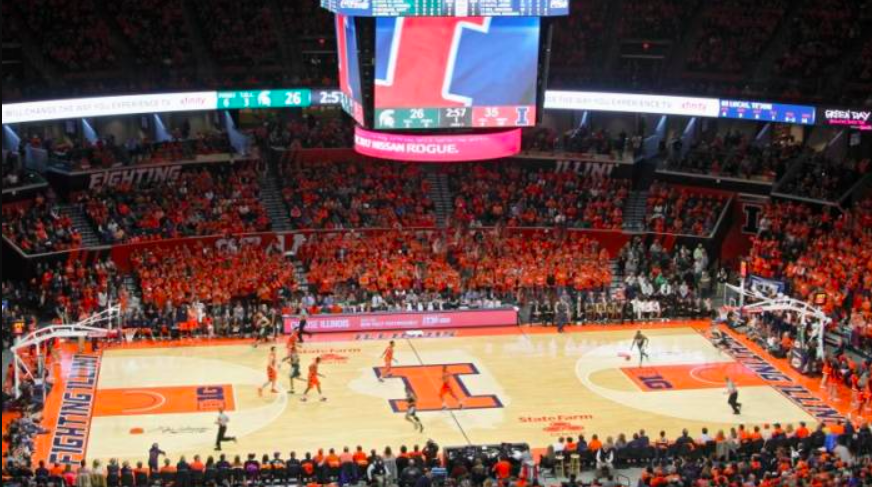For the orange-and-blue–clad denizens of C-U, crisp autumn air is a signifier of tailgating weather. Of course, that also means the Illinois football team’s slide into irrelevance is just a short time away as well. Apologies to Lovie Smith and the noble rebuilding project he’s undertaking, but I think I can speak for a majority of Illini fans when I say that basketball is the real draw.
And as much as cooler weather means football and tailgating, it also means we’re that much closer to hearing the percussive slap of a basketball being dribbled, the snap of the net as a pure shot arcs through, the squeak of high-tops on hardwood, and the raspy voice of a coach yelling. As the rasp from the sidelines changes, however, there’s still only one thing fans want to hear.
One shining moment, you were willing to try…
It’s never really clear what fans should expect from a new coach, or from the players under that coach’s direction. Most coaches come with some kind of pedigree and a spreadsheet of wins, losses, points scored, points allowed, and so on, but how that translates to the new job is a mystery.
Brad Underwood certainly comes to Illinois with the pedigree, requisite high-profile recommendations, and the win-loss record to suggest he can be successful in Champaign. In his open practices and exhibitions, it seems pretty clear that he will get effort from his players — they will try. Whether Illinois is a part of that “One Shining Moment” montage this year? Well, the crystal ball is murky.
Right now, people like Brad Underwood. He’s shiny and new and he talks really earnestly, like an old-school coach. He uses advanced metrics and analysis like the guy he replaced, but is gruff and coaches with a toughness the old guy didn’t have. As humans, we’re attracted to novelty, so Underwood represents something new that we can learn from and enjoy. And everyone loves the honeymoon phase. I’m old enough to remember how much people liked John Groce during his first year (and I may or may not still have a “John F*cking Groce” t-shirt in my closet [I do]).
Beyond the fans, however, excitement over the Illini is tempered. CBS Sports’ Matt Norlander describes this year’s Illini as a “full-fledged rebuild” that will have to “fight to reach the NIT.” In the unofficial poll of Big Ten writers, Illinois was picked to finish 12th in the 14-team league. It’s no surprise, really. Just look at what Illinois is missing from last year:

Aside from Malcolm Hill, not many of those guys will be fondly remembered a decade from now. So, roster turnover is a good thing…maybe. But losing 70% of your scoring is a big challenge, no matter how good or bad the departed players were.
Underwood surely knew he was in for a challenge; he was in for a challenge when he took over at Oklahoma State before the 2016-17 season. What Underwood does, and has done well at each stop in his career, is institute his system. Part of the reason so many players beyond those who graduated left the team, is that they may have realized (through discussions with the coaches or otherwise) that they do not fit well in the system Underwood plays.
That system, as he explained to The Athletic, is “what is happening at the next level — those guys are playing faster, playing position-less. I’ll put a point guard in my pinch post in the spread and put my 6’10” kid out [to the perimeter] because he can shoot it. That’s all I’m trying to do — create the best opportunity for us to score based on matchup.” The system is about space and using it efficiently, making cuts, and attacking the rim. By emphasizing speed, getting a shot off within the first seven seconds of each possession, and aggressive rebounding, Underwood’s style will be unique among Illinois coaches. Hell, among Big Ten coaches. But the results have borne out his wisdom so far.
Last year, Underwood’s OK State shot 32.4% of its shots in the first 10 seconds, 18th among 351 NCAA teams, whereas Illinois shot 22.8% of its shots in the first 10 seconds, 204th. Likewise, the 40% of the Cowboys’ field goal attempts came at the rim, whereas Illinois only attempted 20% of its shots at the rim; however, the percentages of made field goals at the rim were 58.2 for OK State and 67.8 for Illinois. But the biggest, most importantest statistic we can use to glean some info on what change with Underwood represents: Last year the Cowboys led the nation in adjusted offensive efficiency with 126.0 points per 100 possessions and Illinois was 123rd with 107.2 points per 100 possessions (just behind powerhouse Murray State; stats via hoop-math.com and kenpom.com). Which is the long way to show how Underwood found a system that works… when he has the guys to play it.

R-Jr. Michael Finke, 6’10” 230 — F/C
It’s pretty much consensus that Finke is the player with the most to gain in the Underwood system. As a big who can pop from outside, he just seems like the perfect piece, the kind of player that made the Stephen F. Austin a Cinderella (e.g., Thomas Walkup). A career 38% three-point shooter (same percentage Jalen Coleman-Lands shot in 2016-17, FWIW), Finke can spread teams and open up lanes for his teammates. As he told the Athletic: “[Underwood’s system] is so much cutting and just moving without the ball that a lot of teams aren’t used to. When you think something is going on with the ball over there, there are two other things happening off the ball you have to pay attention to. You lose your man, and the moment you blink, something is happening.” That something happening is going to be Finke shooting over a smaller defender. Frequently. Many reports have cited his potential in this system, but also his ability to step up as a leader this year. If that happens, this year will be the year he makes me stop remembering the lanky kid I saw in the halls at Centennial while visiting my wife at work.
So. Te’Jon Lucas, 6’0” 170 lbs — PG
“My type of point guard,” Underwood said of Lucas at Big Ten media day. That’s a big deal, but maybe not the most obvious way. I don’t imagine Lucas ever being a prolific scorer, surely he’ll improve on his 4.8 per game from last year, but I doubt he ever gets on a conference leaderboard—at least not the scoring leaderboard. Where Lucas could find himself, as soon as this year, is among the leaders in assists in the Big Ten. Te’Jon has already shown a special ability for finding the open man, but in the new offense his ability will be even more on display. Lucas will be the conduit in in transition, and if shot within the first 7 seconds doesn’t come his court vision can stand out as he picks out open men or mismatches.
Mark Smith, 6’4” 215 lbs. — G
The weight of expectations for Illinois’s first Mr. Basketball since 2010 will be heavy. But, as a former baseball recruit with something to prove, Smith knows how to rise to the occasion. As a high school senior, Smith routinely looked like a man among boys, but now he’s going against men as big and strong as he is and I’m not unprepared to see a bit of a struggle. However, if he does struggle, I don’t expect it to last. Smith is likely going to be a star, and it may not take long. A guy with a basketball IQ like his can figure out how to succeed, and he’s already shown the will to be a success, so count me as on-board the hype train. Among other passengers, obviously, is Brad Underwood, who said, “I think you could see us literally play Mark at any position on the court. He’s got that kind of versatility.” If and when Smith succeeds, it could go a long way toward making the Illini better in the future (re: recruiting) as well.
R-Jr. Leron Black, 6’7” 220 lbs — Forward
Here’s something that might surprise you, no one on the Illini roster has played more minutes than Black. Despite suspension and injury, the redshirt junior is now the most tenured Illini. But how does that translate to his performance? CBS Sports identified him as one of the top players nationally with something to prove, and I do not disagree. Black is a big, physical guy, and has proven he can bang with the big guys in the Big Ten. In Underwood’s system it seems like he could make a great counterweight to the strong perimeter presence and absolutely clean up on rebounding. With a defense that prioritizes denying the other team, Black looms large.
R-So. Kipper Nichols, 6’6” 225 — F/G
Guys who average 4.9 points per game aren’t usually the best on the team, but I don’t think there’s a player on the Illini roster (at least those we’ve seen play) that is more fun to watch than Kipper. First, he has a motor that never stops running. He will grind at both ends of the court and give everything he has, something Underwood has to love. At times last year he was going too hard and it cost him a possession here and there, but that’s the kind of thing you hope an offseason of growth can correct. The second thing with Kipper is his personality. If you see or hear him off the court, you know he’s a cut-up and generally fun guy. I think that translates to the floor and makes him that much more enjoyable as a player. In the position-less system Underwood prefers, a tweener (not really a guard, not really a forward) like Kipper can excel. Because of his rebounding ability and overall tenacity, I think he’s due for a big leap this year. It may not be a leap to All-Big Ten honors, but maybe a stride toward that.
Mark Alstork, 6’5” 190 lbs — Guard
Welcome to the Illini, Mark Alstork, all that’s expected is that you become one of the team’s leading scorers. No biggie. The Wright State transfer was added to fill the void left by Malcolm Hill, but after the departure of Jalen Coleman-Lands there’s even more of a need for Alstork to get buckets. Scoring, however, is something Alstork has a history of doing. With the Raiders he averaged 12.4 points per game in 15-16 and 19.0 points per game in 16-17, making 38% of his three pointers last year (the same as JCL). There’s a (big) difference in competition between the Horizon League and Big Ten, but if Alstork can average double figures and shoot the three well, he’ll be a great asset. There’s no doubting he will get shots in Underwood’s system.
Trent Frazier, 6’2” 170 lbs. — Guard
Mark Smith might be the big get for Brad Underwood, but keeping Frazier, who was Groce’s recruit, is maybe the most low-key significant thing done by the new staff. A four-star recruit out of Florida, Frazier is about as smooth as guards get and boasts a very pretty shot. However, it’s his explosiveness and ability to use screens to great advantage, thanks to that great outside shot, that are keys to success. The backcourt is not ripe with depth, so Frazier is going to see the court early and often for Illinois. I fully expect some growing pains for him (particularly in January, when Big Ten play starts), but I am very much looking forward to him playing a multiple point guard set alongside Lucas and Smith.
Fr. Greg Eboigbodin, 6’9” 220 lbs. — Forward
This is maybe too high to put Eboigbodin, but with so few big men on the roster it will be crucial for Illinois to have someone dependable ready to go. Eboigbodin was originally recruited by Chin Coleman for UIC, which throws up huge red flags about whether he is a Big Ten-quality player; likewise, he’s only played 3 years of organized ball since coming to America. However, coaches rave about his defensive skills, in particular his ability to grab rebounds, which is a trait that Underwood covets highly in his setup. That will likely be his role this year, to play good defense in his appearances, which could be more numerous than some would want. If you’re worried about him being a project player forced to be part of the rotation (a la Leitch), your worries might not be unfounded: Eboigbodin’s success will likely be measured by how little he screws up. He’s on the roster for long-term growth, with the worst case scenario being that happens and he looks as out of place in 3 years as he will this year. Best case scenario, however, is that he turns into Nnanna Egwu, and that would be just fine. People still don’t value Egwu’s contributions to the Illini like they should.
Jr. Aaron Jordan, 6’5” 190 — Guard
It’s pretty rough ranking Jordan after Eboigbodin, but I honestly thought AJ was gone after last year. Averaging just 1 point and 6.9 minutes as a sophomore, down from his freshman year numbers, I didn’t see where he had a role in 2017. When half the damn team walked out of Champaign with Groce, keeping Jordan became a lot more important for Underwood. What his role is and how successful he is, well that remains to be seen. But I guess the only place to go is up, right? He played 7 minutes in the EIU exhibition. I hesitate to read much into that, but at the same time can’t help but think it’s not a good precedent.
Fr. Da’Monte Williams, 6’3” 185 lbs. — Guard
Most people know Da’Monte as the son of Frank Williams (but not the players!, excellent work by Rob McColley), the man whose drive to the hoop won the Illini the 2002 Big Ten Tournament, among other notable moments. But the younger Williams is not his father. He plays a good guard, as either the point or shooting guard (surely more the latter than the former for Illinois), and he will have a chance to make his own mark. He’s been praised by writers and coaches for his ability as well as his leadership, but he has a tough road before him as he works his way back from a torn ACL. Expectations this year should be low, but he could show real growth this season and beyond.
Matic Vesel, 6’9” 196 lbs. — F
Because he comes from Slovenia, Vesel is still a little unknown. He’s shown good speed and a nice shot, but his defense needs work. He has length, which can’t be taught, and it’s obvious the staff see something in Vesel. With some time in the weight room (seriously, his upper body is lacking) under the tutelage of Adam Fletcher, Vesel could develop into a high-level player with a mid-range jumper that devastates. With just 10 other scholarship players, Vesel is likely to be forced into action, unable to take a redshirt year, but he looks like a project and will likely play like one, too.








